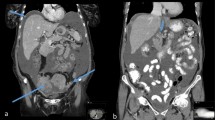Abstract
Purpose
Ovarian cancer is the leading cause of death in gynaecology malignancies. Neoadjuvant chemotherapy (NACT) is currently recommended in advanced ovarian cancer to achieve R0 resection in interval debulking surgery. Morphological changes in tumour cells following NACT have been studied since few years. The present study will be emphasising on five histopathological criteria: fibrosis, necrosis, inflammation, psammoma bodies, residual tumour and their impact on DFS (disease-free survival) and OS (overall survival) in this short period of time.
Methods
All histologically proven cases of carcinoma ovary of FIGO class III–IVA, where primary cytoreduction seemed not possible due to various reasons were included in the study: NACT followed by IDS. Five criteria used to evaluate chemotherapy response on tumour tissue were necrosis, fibrosis, inflammation, psammoma bodies and residual tumour. Scoring was done of each parameter. Patients’ follow-up data were evaluated for around mean follow-up period of 12–13 months to see recurrence, time of recurrence to see DFS period, time of death and complete response time.
Results
The present study revealed the following morphological changes in most patients—severe fibrosis (83%), mild necrosis (86%), mild inflammation (80%) and minimum residual tumour (63%). Psammoma bodies were present in 10% of patients only. Patients exhibiting severe fibrosis, mild inflammation, mild necrosis and the minimum residual tumour had overall longer DFS and OS.
Conclusion
To our knowledge, this is the first study from North India to highlight the importance of the scoring gradation system to evaluate the pathological response of NACT in EOC. Patients with severe fibrosis, higher necrosis and less residual tumour in advanced ovarian cancer after neoadjuvant therapy have an impact on disease outcome. Further studies are needed on a large-scale basis to evaluate and formulate a gradation system for evaluating morphological changes following NACT in EOC so that the exact nature of the disease can be determined along with prognostication of the patient’s survival.

Similar content being viewed by others
Data availability
Not applicable.
References
NCCN Guidelines Version 3. Ovarian cancer. 2022.
Tewari KS, Penson RT, Monk BJ. Tumors of the Ovary and Fallopian Tube. In: DeVita, Hellman, and Rosenberg’s Cancer: Principles and Practices of Oncology. DeVita Jr, Vincent T, Rosenberg, Steven A, et al (eds). LWW, Eleventh edition, 2018
Tiwana KK, et al. Clinical study post chemotherapy histopathological evaluation of ovarian carcinoma: a 40-case study. Chemother Res Pract. 2015;201:4.
Cheng HY, et al. College of american pathologists tumour regression grading system for long-term outcome in patients with locally advanced rectal cancer. Oncol Gastrointest Cancer. 2021;26(5):e780-93. https://doi.org/10.1002/onco.13707.
National Cancer Registry Programme. Three-year report of population-based cancer registries (2009–2011). Indian Council of Medical Research, New Delhi; 2013. p. 56.
Samrao D, Wang D, Ough F, et al. Histologic parameters predictive of disease outcome in women with advanced stage ovarian carcinoma treated with neoadjuvant chemotherapy. Trans Oncol. 2012;5(6):469–74.
Sassen S, Schmalfeldt B, Avril N, et al. Histopathologic assessment of tumour regression after neoadjuvant chemotherapy in advanced-stage ovarian cancer. Hum Pathol. 2007;38(6):926–34.
Khandakar B, et al. Tumour morphology after neoadjuvant chemotherapy as a predictor of survival in serous ovarian cancer: an experience from a tertiary care centre in India: Malaysian. J Pathol. 2015;37(2):115–21.
Mc Cluggage WG, Lyness RW, Atkinson RJ, et al. Morphological effects of chemotherapy on ovarian carcinoma. J Clin Pathol. 2002;55(1):27–31.
Ivantsov AO. Pathological response of ovarian cancer to neoadjuvant chemotherapy. Chin Clin Oncol. 2018;7(6):59. https://doi.org/10.21037/cco.2018.09.07. (PMID: 30509080).
Ditzel HM, Strickland KC, Meserve EE, Stover E, Konstantinopoulos PA, Matulonis UA, Muto MG, Liu JF, Feltmate C, Horowitz N, Berkowitz RS, Gupta M, Hecht JL, Lin DI, Jochumsen KM, Welch WR, Hirsch MS, Quade BJ, Lee KR, Crum CP, Mutter GL, Nucci MR, Howitt BE. Assessment of a chemotherapy response score (CRS) system for tubo-ovarian high-grade serous carcinoma (HGSC). Int J Gynecol Pathol. 2019;38(3):230–40. https://doi.org/10.1097/PGP.0000000000000513.PMID:29750700U.S.
Department of Health and Human Services Food and Drug Administration. Guidance for industry. Pathological complete response in neoadjuvant treatment of high-risk early-stage breast cancer: use as an endpoint to support accelerated approval. 2018. https://www.fda.gov/downloads/Drugs/GuidanceComplianceRegulatoryInformation/Guidances/UCM305501. Accessed 20 July 2018.
Funding
Not applicable.
Author information
Authors and Affiliations
Corresponding author
Ethics declarations
Conflicts of interest
The author declares no conflict of interest.
Additional information
Publisher's Note
Springer Nature remains neutral with regard to jurisdictional claims in published maps and institutional affiliations.
Rights and permissions
Springer Nature or its licensor (e.g. a society or other partner) holds exclusive rights to this article under a publishing agreement with the author(s) or other rightsholder(s); author self-archiving of the accepted manuscript version of this article is solely governed by the terms of such publishing agreement and applicable law.
About this article
Cite this article
Das, M., Yadav, D., Sethi, N. et al. Histopathological Evaluation of Ovarian Carcinoma Post Neoadjuvant Chemotherapy And Its Correlation To Disease Outcome: A Retrospective Study of 30 Cases. Indian J Gynecol Oncolog 21, 79 (2023). https://doi.org/10.1007/s40944-023-00763-z
Received:
Revised:
Accepted:
Published:
DOI: https://doi.org/10.1007/s40944-023-00763-z




